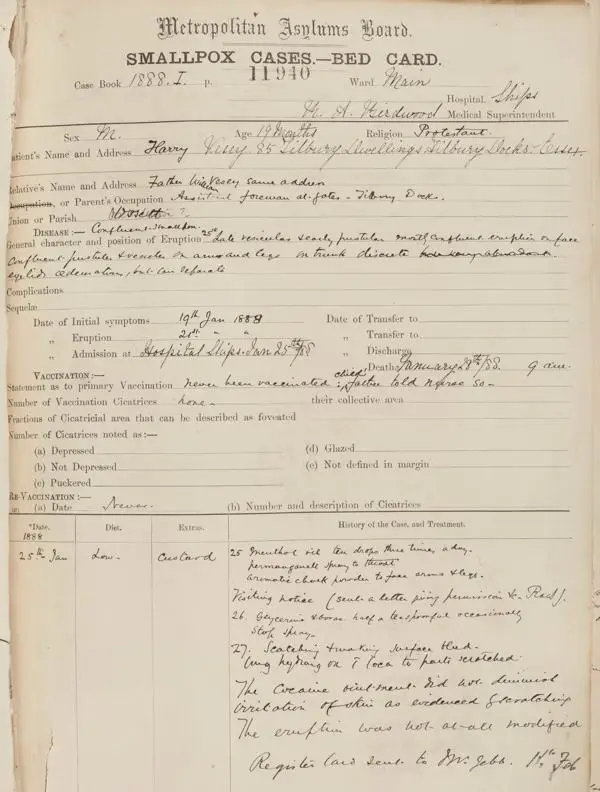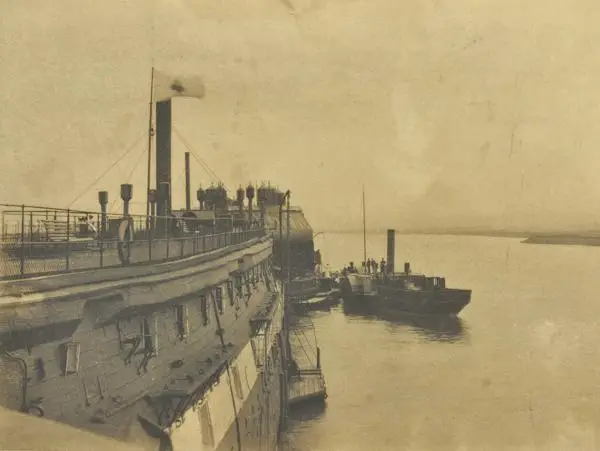Smallpox patient Harry Vesey
In 2013 London Metropolitan Archives was awarded a grant from the Wellcome Trust, through its Research Resources in Medical History scheme, to fund a project entitled Mapping and imaging smallpox in London, 1870-1910. The aim of the project was to make key records relating to smallpox in London - specifically five maps relating smallpox cases to hospitals of treatment, 1873-85, and 360 glass plate negatives of smallpox patients made in the early 1900s - accessible to researchers through a programme of preservation, conservation, digitisation and outreach.
LMA holds data on individual cases represented on the smallpox maps. Here, Howard Benge describes one example of a distressing case of a boy of 19 months, whose father had been advised not to have him vaccinated.
Harry Vesey (19 months old), son of William Vesey, Assistant Foreman at Tilbury Dock Gates, was admitted to hospital with smallpox on 25 January 1888. A barge from one of the hospital ships moored in the Thames at Long Reach, Dartford, Kent had been sent to Tilbury docks with a nurse to collect Harry. His father brought him to the barge telling the nurse that the child had never been vaccinated. With the case notes is a poignant letter from William describing how Harry had fallen ill on 19 January. Once admitted Harry was put on a low diet, and several treatments were applied to alleviate his symptoms including cocaine ointment, but all to no avail as ‘the eruption was not at all modified’. Harry died on 28 January 1888 three days after being admitted and a week since first presenting symptoms.

The notes which describe Harry’s case (H48/B/01/001 case 11940) are preserved in the Joyce Green Hospital archive. The bed card for case no. 11940 states that Harry was admitted to the main ward of the Metropolitan Asylums Board hospital ships moored in the Thames at Long Reach, Dartford, Kent on 25 January 1888 with confluent smallpox. It records the progress of the disease, his symptoms, diet and treatment. On the back of the card, it is recorded that the barge belonging to the hospital ships was towed by the tug Dreadnought, with a nurse and two ship keepers, to Tilbury Docks to collect the patient. Harry’s father would not have been allowed to accompany his son any further as the intention of the hospital ships was to completely isolate patients with smallpox to prevent the spread of the disease. With the bed card for Harry are several letters. It was initially thought that Harry had chicken pox like other family members, but once it was found he had smallpox, William (who was not allowed to go to work by the doctor) decided to nurse Harry himself shut in a room within the home. Following Harry’s removal, the whole household was isolated within their block of dwellings, but William’s wife developed symptoms and tried to drown herself.

Other children with smallpox
The notes which describe Harry’s case are preserved in the Joyce Green Hospital archive. This also contains photographs taken by J B Byles of children with smallpox taken in connection with The Diagnosis of Smallpox (1908) by T F Ricketts, Medical Superintendent of the Smallpox Hospitals of the Metropolitan Asylums Board and the leading authority of the time on smallpox (H48/Y/01/003). These show children at various stages of the disease or presenting with diseases that might be mistaken for smallpox, including chickenpox.
Some children were part of a group of 13 patients given red light treatment which involved being confined in a room completely shut in with red curtains. Ricketts and Byles concluded the treatment was harmful rather than beneficial, especially as it restricted the supply of fresh air to patients.